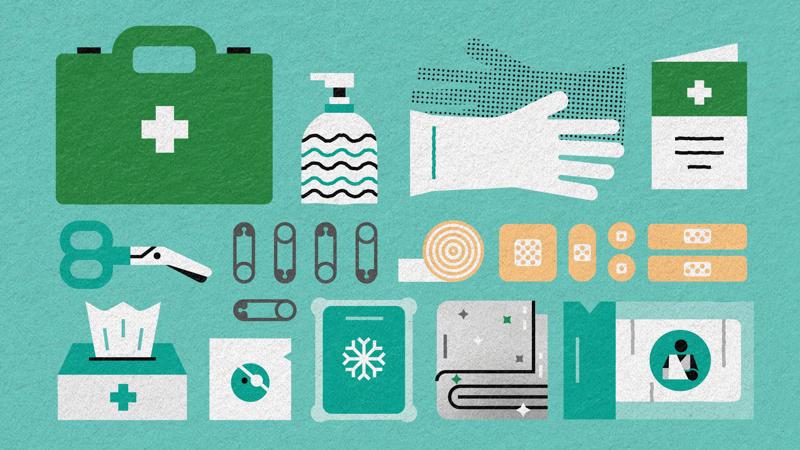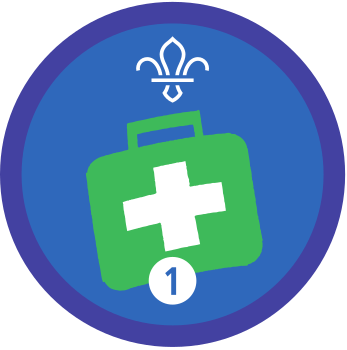
Be an emergency aider: circulation
You’ll need
- Big pieces of paper
- Pens or pencils
- Sticky tack
- Bandages
- First aid kit
Before you begin
- Make sure the person leading the activity knows about first aid. Someone from your group or local area with a first aid certificate could take charge, or you could reach out to places that help provide first aid training or support, for example, St John Ambulance or the British Red Cross.
- You’ll need enough leaders for the activity, including enough people who are happy to demonstrate first aid techniques.
- Adults should only demonstrate and practise first aid on other adults; young people should only demonstrate and practise first aid on other young people. Adults and young people should never demonstrate or practise first aid on each other.
- Make sure you have enough bandages for everyone to practise – this is a great chance to use up any out-of-date supplies to save breaking into your first aid kit.
- Stick two pieces of A3 paper on the wall so everyone can see them.
Chat about types of bleeding
- Get everyone to sit in a semi-circle and start a conversation about different types of bleeding. As they name types, write them on one of the pieces of paper. After, open the group’s first aid kit and show everyone what’s inside.
- Ask another adult to help show everyone how to respond to the different types of bleeding.
- Show everyone how to clean a minor cut or graze with water or sterile wipes and cover it with a plaster.
- Next show everyone how to deal with a nosebleed and demonstrate how to pinch the adult casualty’s nose and position them to help stop the bleeding. They should explain what they’re doing every step of the way.
- Tell everyone about severe bleeds and different things that may cause them. Show everyone how to tie a bandage around a wound, using another adult as the casualty.
- Everyone should get into pairs of young people. Each pair should take it in turns to practise putting a bandage on their partner. Make sure adults walk around so they can help if anyone’s finding it tricky.
- Once everyone’s finished practising, explain that bandaging is different if there’s a foreign object poking out of the body. They should make sure everyone knows that they shouldn’t remove the object.
- The adult casualty should hold a pen next to their body, as a pretend foreign object. Show everyone how to put pressure on either side of the object with bandages, until it’s secure.
- Everyone should get back into their pairs of young people. They should take it in turns to practise bandaging around a pen that their partner’s holding next to their body. Make sure adults walk around so they can help if anyone’s finding it tricky.
Deal with shock
- Explain to everyone that when someone gets hurt or injured they may go into shock. This doesn’t mean emotional shock – it’s a life-threatening condition that happens when the body isn’t getting enough oxygen to the vital organs.
- Everyone should work together to remember the signs and symptoms of shock. Someone should write them all on the second piece of A3 paper.
- Demonstrate how to treat someone for shock, using another adult as the casualty.
- Everyone should get back into their pairs of young people. They should take it in turns to explain how they’d look for shock, and practise treating their partner for shock. Make sure adults walk around so they can help if anyone’s finding it tricky.
Minor cuts and grazes
- Cuts are when the skin is fully broken.
- Grazes happen when the top layers of skin have been scraped off.
Nosebleeds
- Nosebleeds are when blood flows from the nose – they usually happen when tiny blood vessels inside the nostrils are ruptured.
- Lots of different things cause nosebleeds, including being hit on the nose, sneezing, and picking your nose.
Severe bleeding
- Larger wounds can cause the casualty to bleed a lot, this is where there is a larger wound and it is causing the casualty to bleed a lot.
- Bleeding needs to be controlled quickly – the priority is to stop the bleeding.
Foreign objects in a wound
- Foreign objects can become lodged in a wound and cause the casualty to bleed a lot.
This information is correct as of June 2020. For the most up-to-date information, check with St John Ambulance.
- Pale skin, which may be cold and clammy.
- Fast pulse - as shock gets worse.
- Fast, shallow breathing.
- A weak pulse.
- Grey blue skin, especially inside the lips.
- Nausea and possible vomiting as the brain's oxygen supply decreases.
- Restlessness and aggressive behaviour.
- Yawning and gasping for air.
- The casualty could become unresponsive.
Reflection
This activity helped people to be responsible. It’s useful to be able to treat everyday cuts and grazes. What is it important to do when an injury is more serious? People might think about getting help fast and treating bleeding, then treating for people to shock. This could stop an injury getting worse and even save someone’s life.
This activity was also about learning essential skills. Did people practise bandaging different parts of their partner’s body? Were any easier than others? It might have been easier to elevate an arm compared to a tummy, for example. How did people remember the signs and symptoms of shock? Different people may have found different things helpful, for example, creating a rhyme, repeating the list over and over again, or even picturing the signs and symptoms.
Safety
All activities must be safely managed. You must complete a thorough risk assessment and take appropriate steps to reduce risk. Use the safety checklist to help you plan and risk assess your activity. Always get approval for the activity, and have suitable supervision and an InTouch process.
If anyone can’t reach their casualty, or is unable to do things like bandaging or raising the casualty’s legs, they can still learn so they can instruct others. They may want to get into a group of three, so they can tell a third person what to do to help the casualty.
All Scout activities should be inclusive and accessible.
Put people’s skills to the test by creating some scenarios in your meeting place. Once groups enter, they’ll need to do a primary survey to work out what they need to do. You could also combine the skills people learned in this activity with other emergency aid skills and organise an incident hike.
Young people with first aid qualifications could help others if they’re struggling, with a leader supervising.
